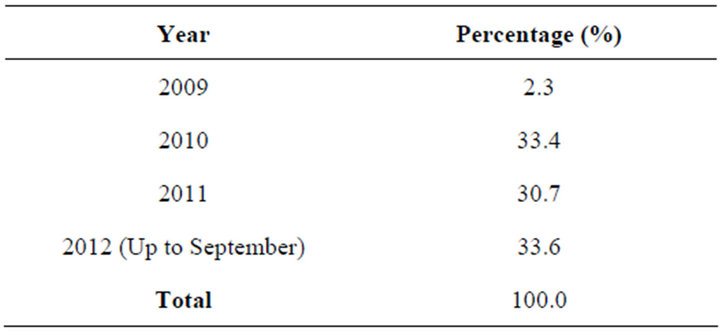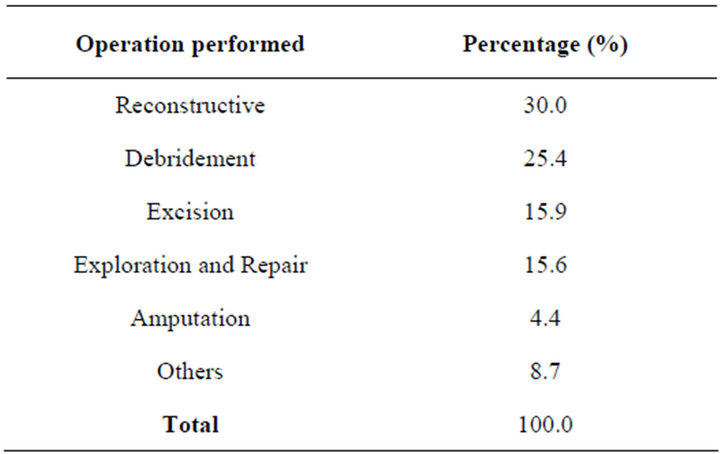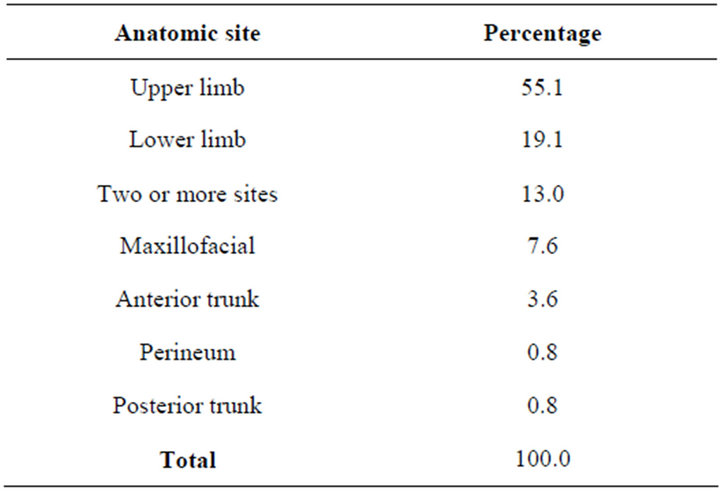Modern Plastic Surgery
Vol.3 No.3(2013), Article ID:33955,4 pages DOI:10.4236/mps.2013.33020
A Short Term Review of Operated Cases in the Plastic Surgery Unit at the Komfo Anokye Teaching Hospital, Kumasi, Ghana*
![]()
1Reconstructive Plastic Surgery & Burns Unit, Department of Surgery, Komfo Anokye Teaching Hospital, Kumasi, Ghana; 2School of Medical Sciences, Kwame Nkrumah University of Science and Technology, Kumasi, Ghana.
Email: #pimagben@yahoo.com
Copyright © 2013 Pius Agbenorku et al. This is an open access article distributed under the Creative Commons Attribution License, which permits unrestricted use, distribution, and reproduction in any medium, provided the original work is properly cited.
Received April 1st, 2013; revised May 3rd, 2013; accepted May 10th, 2013
Keywords: Reconstructive Plastic Surgery; Congenital Anomalies; Injuries; Surgical Operations; Short-Term Review
ABSTRACT
Introduction: Surgical problems are of much disturbance to the world and should therefore be given serious attention. The prevalence of these surgical problems, has made plastic surgery become a broadly relevant and acceptable way for addressing problems like injuries, congenital anomalies, surgical infections and malignancies among others. Aim: This study is to quantify and characterize surgical procedures done in the plastic surgery theatre located in the new Accident and Emergency (A & E) Building of KATH. Materials and Methods: Data were obtained from the Operation Register/Theatre Books in the plastic surgery theatre at the A & E Centre on cases operated on from October 1, 2009 to September 30, 2012. Data entry, presentation and analysis were done using Statistical Package for the Social Sciences (SPSS) 20.0 version. Results: Adults formed the majority of patients who sought for plastic surgery with a percentage of 70.3%. The male patients also outnumbered the females recording (61.5%) out of the total number of patients. Most of the cases recorded were acquired cases (93.2%). Reconstructive surgery was the commonest operation performed (30%); in 53.8% cases general anaesthesia was used. Conclusion: Among all the procedures used reconstructive surgery was the commonest surgery performed in the unit and general anaesthesia was the most type of anaesthesia used for the operations.
1. Introduction
Surgical conditions account for 11% of the total global burden of disease [1]. Again surgical patients are responsible for approximately 6% - 12% of all pediatric admissions in sub-Saharan Africa and the commonest admission diagnoses were injuries, congenital anomalies, and surgical infections [2]. Plastic surgery (reconstructive and cosmetic surgery) is broadly relevant to the unmet needs for surgery in developing countries [3]. Several conditions are addressed by plastic surgeons. These include burns, traumatic injuries, infections, malignancies, lacerations, tumors and congenital anomalies (cleft-lip and palate deformities, breast abnormalities, and webbed fingers) [1-4].
The estimated percentages of injuries, malignancies and congenital anomalies make up more than half of the world’s burden of all surgical diseases [1]. These conditions determine the type of plastic surgery to be undertaken. Reconstructive surgery can improve function to areas of the body by correcting abnormalities caused by developmental problems, injuries, infections, tumors, or diseases. It is also used to give or restore a normal appearance [3].
Plastic surgery like any other surgery employs anaesthesia. The type of anesthesia used during one’s surgery typically depends upon the type of surgery, the part of the body where the surgery is being performed, medical history, state of health, the length of the surgery and the preferences of anesthesia provider and surgeon [5,6]. Some classifications of anaesthesia are local, regional (sedation, spinal, epidural) and general [6-12].
Since surgical problems are of much disturbance to the world they should be given serious attention. The prevalence of these surgical problems have made plastic surgery become a broadly relevant and acceptable way for addressing problems such injuries including burns, congenital malformations, malignancies, etc. This study was designed to quantify and characterize surgical procedures done in the plastic surgery theatre located in the new Accident and Emergency (A & E) Building of the Komfo Anokye Teaching Hospital (KATH).
2. Materials and Methods
2.1. Study Setting
Komfo Anokye Teaching Hospital (KATH) is the second largest hospital in Ghana and the only tertiary health institution in the middle belt of the country. It is located in the Ashanti Region and therefore serves as the main referral hospital for the Ashanti, Brong Ahafo, Northern, Upper East and Upper West regions. The Reconstructive Plastic Surgery and Burns Unit was started when the first plastic surgeon arrived in 1993. He was joined by two other plastic surgeons in 2004 and 2005 respectively. The unit currently has four consultant plastic surgeons and three plastic surgical trainees (residents/registrars). A variety of surgical procedures has been accomplished over the years. The unit is in the process of making a comprehensive list of the procedures carried out which is important for the purposes of planning and resource allocation. The aim of this study is to quantify and characterize surgical procedures done in the plastic surgery theatre located in the new A & E Building of KATH.
2.2. Limitations to the Study
1) Only cases that were recorded in the main operating theatre book of the plastic and reconstructive unit that had all data available were used.
2) Cases with insufficient data, and whose particulars could not be obtained in the nurses records as well were not included.
3) Cases that were operated by joint/multidisciplinary units which were not recorded in the plastic surgery theatre books were excluded from the study.
4) Some of the cases that were illegibly recorded by doctors or ambiguous were excluded from the study.
2.3. Data Collection
Data was obtained from the operation registers in the plastic surgery theatre at the A & E Centre on cases operated on from October 1, 2009 to September 30, 2012. Data collected included: cases operated by or under the supervision of any of the four consultants in the Reconstructive Plastic Surgery & Burns Unit of KATH with sufficient data from both the doctors’ and nurses’ operation registers. Demographic data collected were age and sex of the patients; also, data on the year of surgery of patient, pre-operative diagnosis, operative procedure performed on the patient, type of anesthesia, rank of surgeon and anatomic site involved were collected.
2.4. Data Analysis
Data entry, presentation and analysis were done using Statistical Package for the Social Sciences (SPSS) 20.0 version.
2.5. Ethical Clearance
Ethical clearance was obtained from the Kwame Nkrumah University of Science and Technology School of Medical Sciences/Komfo Anokye Teaching Hospital Committee on Human Research, Publication and Ethics, Kumasi.
3. Results
Out of the 1964 patients who reported at the unit, 24.6% (n = 483) were children, 70.3% (n = 1381) were adults and 5.1% (n = 100) were elderly; 61.5% (n = 1208) were males and remaining 38.5% (n = 756) were females. Patients with congenital cases accounted for 6.8% (n = 134) out of the total patient population whilst 93.2% (n = 1830) presented with acquired cases. The surgeons involved in the surgical procedures were KATH consultants (62.3%), KATH residents (33.5%) and visiting consultants (4.2%). The types of anaesthesia used in the surgeries include; general (53.8%), local (21.4%), regional (15.1%) and spinal (9.1%).
3.1. Number of Cases
In last quarter of 2009 when the research began, the number of cases recorded in the unit was 45 (2.3%) patients, 657 (33.4%) patients in 2010, 603 (30.7%) patients in 2011 and 659 (33.6%) patients in the first nine months of 2012 as shown in Table 1.
3.2. Operations Performed
Reconstructive operation, debridement, excisions, explo-

Table 1. Number of cases.
ration and repair, amputation and other operational methods were surgeries carried out as shown in Table 2 below.
3.3. Anatomic Sites of Injury
Parts of the body where surgeries were performed included upper limb, lower limb, two or more sites, maxillofacial, anterior trunk, perineum and the posterior trunk as indicated below in Table 3.
4. Discussion
American Society for Plastic Surgery’ (ASPS) research reported 90% females out of the total population of patients sought for plastic surgery [13]. Linkage with gender distribution for cosmetic procedures also showed that females are the majority who seek for cosmetic plastic surgery with a percentage range (90.6% to 92%) from 2009 to 2011 [14]. These researches are in contrast with our findings since the male patients outnumbered the female patients recording 61.5% of the total number of patients. This is explained by the fact most of the procedures in our series of surgeries were more of reconstructive rather than cosmetic.

Table 2. Operations performed.

Table 3. Anatomic sites of injury.
American Society for Aesthetic Plastic Surgery’ (ASAPS) statistics on age of plastic surgery patients in relation with cosmetic procedures showed that adults formed the majority of people who seek for plastic surgery with an average of 60.2%, followed by the elderly (25.3%) and then children (1.6%) from 2009 to 2011 [14]. This finding is similar to our results as adults recorded the highest percentage of 70.3% with a diverse change in the percentages of children (24.6%) and elderly (5.1%). This gives an indication that adults are more concerned about their physical appearance in general and are exposed to much risks and injuries in their daily activities.
Most of the cases presented at the unit for treatment were acquired; burns, traumatic injuries, infections, malignancies, lacerations, tumors, ulcers, etc. whilst a few presented with congenital cases like cleft-lip and palate deformities, breast abnormalities and others and this similar findings have been reported by the World Health Organization (WHO) and others [2-4].
There are many surgical procedures and they increase as time goes on [13-15]. Surgical procedures used in the unit involved reconstructive, debridement, excisions, exploration and repair, amputation amongst others based on the part of body, the nature of wound and the level of infection. The leading procedure used in the unit as shown in the current study is reconstructive (30%). According to National Plastic Surgery statistics in America there was 5% change in the use of reconstructive surgery from 2008 to 2009, a 2% increase from 2009 to 2010 and 5% increase from 2010 to 2011 [13]. This current study should be repeated after 5 - 10 years and the appropriate trend of plastic, reconstructive and aesthetic procedures would be accurately investigated as had been done by the American groups.
5. Conclusion
There has been a tremendous increase in the number of procedures of plastic surgery over the last few years, but reconstructive surgeries and wound debridement are the main procedures used in the Komfo Anokye Teaching Hospital with general anaesthesia as the leading type of anaesthesia employed. Many researchers have reported a female predominance in plastic surgery but this should not be a concluding matter since male plastic surgery cases are prevailing and increasing in time passage in our institution. In all, adults form the majority of patients since they care much about their appearance and are exposed to risks of accidents and injuries in their daily activities.
REFERENCES
- H. Debas, R. Gosselin, C. McCord and A. Thind, “Surgery,” In: D. Jamison, Ed., Disease Control Priorities in Developing Countries, 2nd Edition, Oxford University Press, New York, 2006, pp. 1245-1259.
- “Emergency and Essential Surgery: The Backbone of Primary Health Care,” WHO, 2013. http://www.who.int/eht/sb/en/index.html
- “Types of Plastic Surgery,” 2013. http://www.superpages.com/supertips/plastic-surgery.html
- Wikipedia the Free Encyclopedia, “Plastic Surgery,” 2013. http://en.wikipedia.org/wiki/Plastic_surgery
- J. Heisler, “Anesthesia and Surgery, Anesthesia: What You Need to Know, About.com Guide,” 2013. http://surgery.about.com/od/proceduresaz/a/AnesthesiaHub.htm
- Types of Anaesthesia for Cosmetic Surgery, 2012. http://www.costhetics.com.au/news/types-of-anaesthetic-for-cosmetic-surgery
- “Healthcare-e.4 Types of Anesthesia Used during Plastic Surgery,” 2013. http://www.guides.healthcare-e.org/4-types-of-anesthesia-used-during-plastic surgery.php
- K. J. Norton, “Types of Anaesthesia,” 2013. http://www.worldwidehealth.com/health-article-Endometriosis-Part-73-Types-of-Anesthesia-.html
- M. Moore, “Types of Anesthesia,” 2012. http://www.drmarkmoore.com/Articles/types_of_anesthesia.htm
- R. E. Iverson, “Anesthesia and Plastic Surgery,” Consumer Guide to Plastic Surgery, 2013. http://www.yourplasticsurgeryguide.com/checklists/anesthesia.htm
- “Types of Anaesthesia and Your Anaesthesiologist,” Guide to the Diagnosis, Treatment and Prevention of Conditions from A to Z, Health Library, 2013. http://www.hopkinsmedicine.org/healthlibrary/conditions/surgical_care/types_of_anesthesia_and_your_anesthesiologist_85,P01391/
- “Types of Anaesthesia,” Children’s Hospital of Wiscon, 2013. http://www.chw.org/display/PPF/DocID/22098/router.asp
- “2012 Plastic Surgery Procedural Statistics,” American Society of Plastic Surgeons, 2013. http://www.plasticsurgery.org/news-and-resources/2012-plastic-surgery-statistics.html
- “American Society for Aesthetic Plastic Surgery,” Statistics, 2013. http://www.surgery.org/media/statistics
- Amanda Genge, “Teens and Plastic Surgery: Is it Safe?” Complete Wellness Center, 2009. http://cerner.healthatoz.com/Atoz/hc/chi/teen/teensurgery.asp
NOTES
*Conflict of interest: The authors declare no conflict of interest.
#Corresponding author.

